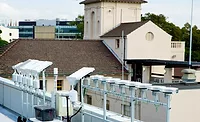...Every Kind of Roof Coating Under the Sun
There are a variety of roof coatings available in North America today. These high-performance coatings provide a variety of benefits, such as moisture resistance, reflectivity, abrasion resistance, corrosion resistance and ultraviolet (UV) resistance.

There are a variety of roof coatings available in North America today. These high-performance coatings provide a variety of benefits, such as moisture resistance, reflectivity, abrasion resistance, corrosion resistance and ultraviolet (UV) resistance. These coating properties come from the components that are used to formulate the coating. But these components and how they are formulated into the product will determine the handling properties and how the coating will cure and perform when applied on the roof.
Exterior-grade roof coatings are all typically formulated using three basic raw material categories: pigments, resins and a liquid carrier. These components first stabilize the coating so it can be packaged, delivered to the roof and applied onto the surface. The remaining ingredients bind together to form the protective film and provide the desired service once the coating has fully cured.
Even though coatings are typically classified by the type of resin (or polymer), we can also categorize coatings by the liquid carrier. More specifically, roof coatings types are broken into the following categories:
In spite of the wide differences in the makeup of the products in these three categories, they are for the most part very similar in application and handling. This article will describe the unique properties of each category of coating and detail the potential issues that may arise with the application and function of these coatings on the roof.
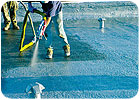
The foremost advantage of a solvent-based coating is the ability to be stored and applied under cool weather conditions. A solvent-based coating will withstand freezing temperatures during storage without damage, whereas a waterborne coating can become permanently damaged by this exposure. In addition, during application in cold temperatures, the solvent will continue to "flash off," or evaporate, unlike the waterborne coatings, whose cure rate will come to a standstill. Films from a solvent-based coating are not susceptible to damage from freezing, since there is no water for ice crystals to form.
Solvents typically have a much faster evaporation rate than water. A fast evaporation is desired so the coating can successfully form a film and cure in order to support foot traffic and resist rain wash-off. However, the evaporation rate of the solvent must be matched to the coating system. If the solvent evaporates too fast, the coating may not properly adhere, flow, or self level. If the solvent evaporates too slowly, the coating may sag or may thin out in areas.
In addition to evaporation rate, "solvency" is another key property considered when formulating a coating. The solvent must be strong enough to suspend the resin (or polymer) within solution at a viscosity low enough to be applied at the ideal coverage rate. If the solvent is not strong enough, the coating may be susceptible to settling of solids and resulting in poor properties of the coating film due to inconsistent coverage. Even when a coating has good solvency, it is always a good idea to mix each container prior to application to assure the components have not separated during storage.
On porous surfaces, solvents help to wet out the substrate, which allows the coating to penetrate and develop stronger adhesion. When applied over previously coated surfaces, the solvent conditions the surface, which helps improve the bond of the new coating to the existing. As a final note, the solvent in the new coating must not soften the existing coating so much that it softens and lifts the previous coating from the surface. Application of a test patch is always recommended to ensure compatibility and proper adhesion.
When specified, primers can help improve adhesion of a coating. A primer usually has more solvent and less solid material than a top coat, so the primer can penetrate into the substrate and make the surface more similar to the intended top coat; therefore, the adhesion between these compatible surfaces will be better than without the primer. A primer can also function as a way to hold down minor contaminants, such as dust, which can inhibit adhesion and act as a bond breaker to a coating.
The strength of the solvent must be balanced by other factors, such as environmental and safety aspects. Certain solvents, such as those containing chlorine and benzene, can be toxic in high concentrations. Products containing these types of solvents should only be specified in situations where there is sufficient fresh air that the solvent concentration in the air will not exceed OSHA action levels or where the installer is protected with a properly fitted respirator that is designed to protect the user from organic vapors.
Another potential issue with solvent-based coatings is flammability. Because most solvents are petroleum-based and volatile, they generate a vapor that can combust when in enclosed areas and exposed to a spark or flame source. Flammability issues with solvent-based coatings can be addressed by using coatings containing chlorinated solvents, which are noncombustible due to the fire-retardant properties of chlorine.
Many chlorinated solvents are no longer available due to their status as ozone-depleting chemicals. Solvents such as Trichloroethylene and Trichloroethane, in spite of their advantage of having excellent solvency and fire resistance, have been limited by international agreement through the Montreal Protocol because they are believed to have a destructive effect on the ozone layer. There are other chlorinated solvents still available, such as methylene chloride, which are not reactive with ozone, but the potential health issues with overexposure have led to their decreased usage.
Odor will most always be a primary characteristic of solvent-based coatings. Since solvents are usually highly volatile, their unique odor will often reveal the application of a coating. The best approach to managing solvent odor starts prior to the coating installation. Schedule the coating project for a time when few building occupants are present, such as over a weekend or holiday. If this is not possible, notify the building occupants prior to starting the project, so individuals with health issues have the opportunity to relocate. During the project, shut down air intakes in the application area, but provide fresh make-up air from other locations. Depending on the coating type, the odor is typically eliminated within two to four hours of application due to the fast evaporation rate.
The Environmental Protection Agency (EPA) and other local air quality districts currently regulate the amount of solvent permitted in each commercial category of coating with the goal of reducing ground level ozone and smog and improving air quality. Reputable manufacturers have addressed these issues and market coatings that are compliant with the regulations that limit volatile organic compounds (VOCs). These new regulations have made an impact by driving some traditional coatings from the market, but have also had the effect of spurring advancements in coating technology.
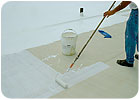
In waterborne coating formulations, the polymers and pigments are not dissolved within the system. Instead, these solids are diluted in water so the coating can flow and be easily applied. In addition to water, there may be a small amount of solvent-based material to provide additional properties to the coating, such as freeze resistance and improved film formation.
Upon application, the water evaporates and diffuses through the coating film or absorbs into the substrate. Once the water is released from the coating film, the coating film compresses and fuses together with the surface and begins to achieve its final cure.
Once a roof coating has dried enough to support foot traffic, the actual time it takes to fully cure may be another two to four weeks after application. The resin or polymer needs time to create molecular cross-linkages, also described as the final cure. During the cure period, freshly applied waterborne roof coatings have a few limitations that must be understood. First, the roof coating is susceptible to reversion in areas where water collects. Even though the coating quickly develops wash-off resistance, the coating film will soften and lift when immersed in ponds or even small "birdbath" areas. Second, the applied coating may be susceptible to dirt pickup until the polymer is fully cured. Finally, adhesion to the substrate is increasing during this cure period.
After a few weeks, the waterborne roof coating will provide excellent performance with respect to water resistance, dirt pickup, and adhesion to the substrate. However, during the cure period these performance aspects have not fully developed and will not until the coating has achieved its final cure. One way to help ensure a successful coating application is to specify a tapered roof insulation system to help remove water rather than allowing water to collect in dead level roof areas. If the coating is part of a new roof system and it is late in the year (after Oct. 1), it may be justified to wait to apply the waterborne coating the following spring when days are longer and the nights are warmer.
Waterborne coatings have important advantages that have led to their growing usage. With water instead of solvent as the liquid carrier, the coatings have low flammability. These coatings will not ignite in the presence of a spark or flame during application. This is a great safety advantage for the contractor. Another advantage is that contractors are able to use the same equipment to apply waterborne coatings as they use with solvent-based coatings. Also, the minimal odor of the coating will pose fewer concerns for the occupants and building operations.
The fact that waterborne roof coatings are low in VOCs has been one reason for their growth and wide acceptance. Regulations regarding the amount of solvent contained within a coating formulation were first enacted in California, expanded to individual cities, counties, and states across the country, and are now in force across the United States either through state provisions or the the EPA's National Architectural Coatings Regulation. In these regulations, coatings are categorized by type and usage, such as "roof coatings," "metallic pigmented coatings" and "bituminous coatings." It is much easier for waterborne coatings to meet the VOC requirements in these categories.
Some localities, such as the South Coast Air Quality Management District (SCAQMD), which is located in the four-county area surrounding Los Angeles, have written VOC regulations that are more stringent than the EPA's National Architectural Coatings Regulation. The strategy of the SCAQMD is to review existing coating technology and to initiate VOC Standards to mandate coatings that use the lowest amount of VOCs for a particular product category. The SCAQMD currently allows only roof coatings with less than 50 g/L of solvent. This is the lowest VOC level for this category of coatings in North America today. It has been a challenge to manufacturers to meet this limit. Certain properties relied on by contractors, such as freeze/thaw resistance of a coating, may be affected. The coatings that work in Southern California with its warm climate may not necessarily work in other parts of the country with cooler weather.
It is obvious that waterborne coatings must be applied in warm weather conditions. However, the subsequent nighttime temperatures and weather conditions on the following day are just as important for the successful cure and long-term performance of any waterborne coating. Temperatures above 50°F should be present for 24 to 48 hours after application or else the water may not sufficiently evaporate from the coating film. At temperatures below 40°F, the water release and cure rate may come to a complete standstill, leaving the freshly applied coating vulnerable to wash-off, dirt pickup, or damage from freezing temperatures.
In addition to warm temperatures, sunlight, wind and humidity also play an important role in drying and curing a waterborne coating film. Sunlight helps to warm the surface, while a breeze helps carry away the moisture evaporating from the coating film so that it can skin over. Sunlight is very important for warming a cold surface prior to application of the waterborne coating. However, on days with cold air temperatures, sunlight may not provide much help in the drying process since a freshly applied white coating is highly reflective. As for relative humidity, if the moisture level in the air is high (above 90 percent RH), a freshly applied waterborne coating film may not be able to effectively evaporate the water into the air since it is already highly saturated with moisture.
Waterborne coatings have a reasonably good shelf life, typically one year. Mixing the product prior to application is always a good recommendation to ensure a uniform blend of the coating components. After application, clean up with water is recommended, even for brushes, spray equipment, tools, and on areas where coating may have been freshly splashed or spilled.
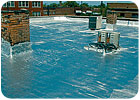
The multi-component or moisture cure type of roof coating is usually based on some type of high-performance reactive polymer or resin that will impart a desirable property within the finished coating, such as chemical resistance, long term color fastness (non-yellowing), abrasion resistance, corrosion resistance, impact resistance, or high elongation. These types of coatings for the most part are formulated so that odor is minimal or virtually nonexistent.
An excellent feature of multi component coatings is their package stability. Prior to mixing, the components are typically very stable with a long shelf life. The individual components may be caustic or hazardous in some other way, such as with the components of epoxy coatings, but once they are mixed together, the coating fully reacts within a definitive time period. Depending on the type of coating, the pot life may be as little as 30 seconds or as long as eight hours. Cool ambient temperatures may extend these cure times.
For a multi-component coating with an extremely short pot life, such as polyure coatings, a plural component spray pump is required. Plural component spray systems consist of two separate pumps, which pressurize each component separately and then combine parts A and B of the coating within the spray gun and immediately spray the mixed components onto the roof surface. These plural component coatings spray systems may also provide heated hoses to maintain a consistent reaction temperature. Coatings with a pot life of one hour or more can be mixed in pails and applied by roller or conventional spray equipment.
Moisture cure coatings are typically sealed within the container under a "blanket" of nitrogen gas, where this inert gas is blown across the top of the coating during packaging.
The nitrogen in the dead air space of the container displaces air that may have contained moisture, which in turn protects the coating in the container from beginning to skin and cure. Moisture cure urethanes are a common example of this type of coating. The shelf life of moisture cure coatings may be limited to as little as six months. Also, once the container is opened, it is difficult in the field to properly reseal the container to keep the remaining material from curing in the container, so it is best to use the entire contents once the package is opened.
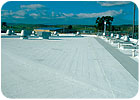
Each different type of coating offers its own set of advantages and limitations. The project team must be familiar with all of these criteria in order to provide the best recommendations to a building owner to assure the coating will provide all of the benefits anticipated by the building owner.

There are a variety of roof coatings available in North America today. These high-performance coatings provide a variety of benefits, such as moisture resistance, reflectivity, abrasion resistance, corrosion resistance and ultraviolet (UV) resistance. These coating properties come from the components that are used to formulate the coating. But these components and how they are formulated into the product will determine the handling properties and how the coating will cure and perform when applied on the roof.
Exterior-grade roof coatings are all typically formulated using three basic raw material categories: pigments, resins and a liquid carrier. These components first stabilize the coating so it can be packaged, delivered to the roof and applied onto the surface. The remaining ingredients bind together to form the protective film and provide the desired service once the coating has fully cured.
Even though coatings are typically classified by the type of resin (or polymer), we can also categorize coatings by the liquid carrier. More specifically, roof coatings types are broken into the following categories:
- Solvent based.
- Waterborne.
- Multi-component reactive, moisture cure.
In spite of the wide differences in the makeup of the products in these three categories, they are for the most part very similar in application and handling. This article will describe the unique properties of each category of coating and detail the potential issues that may arise with the application and function of these coatings on the roof.

In this photo, a roof contractor is using plural component spray equipment to recoat an existing SPF system with a two-component polyurea coating over a urethane primer. This polyurea coating cures within 30 seconds of application.
Solvent-Based Coatings
Most traditional roof coatings are formulated using a solvent (other than water) to dissolve the solids (pigment and resin) so they can be applied in a uniform film on a surface. These solvents are hydrocarbon or chlorinated solvents that evaporate at a rate much faster than water. Some of these solvents are mineral spirits (naphtha or turpentine), toluene, xylene, acetone, MEK, methanol, trichloroethane, and methylene chloride. These solvents have been used in many durable, highly reflective, protective roof surface finishes over the past century.The foremost advantage of a solvent-based coating is the ability to be stored and applied under cool weather conditions. A solvent-based coating will withstand freezing temperatures during storage without damage, whereas a waterborne coating can become permanently damaged by this exposure. In addition, during application in cold temperatures, the solvent will continue to "flash off," or evaporate, unlike the waterborne coatings, whose cure rate will come to a standstill. Films from a solvent-based coating are not susceptible to damage from freezing, since there is no water for ice crystals to form.
Solvents typically have a much faster evaporation rate than water. A fast evaporation is desired so the coating can successfully form a film and cure in order to support foot traffic and resist rain wash-off. However, the evaporation rate of the solvent must be matched to the coating system. If the solvent evaporates too fast, the coating may not properly adhere, flow, or self level. If the solvent evaporates too slowly, the coating may sag or may thin out in areas.
In addition to evaporation rate, "solvency" is another key property considered when formulating a coating. The solvent must be strong enough to suspend the resin (or polymer) within solution at a viscosity low enough to be applied at the ideal coverage rate. If the solvent is not strong enough, the coating may be susceptible to settling of solids and resulting in poor properties of the coating film due to inconsistent coverage. Even when a coating has good solvency, it is always a good idea to mix each container prior to application to assure the components have not separated during storage.
On porous surfaces, solvents help to wet out the substrate, which allows the coating to penetrate and develop stronger adhesion. When applied over previously coated surfaces, the solvent conditions the surface, which helps improve the bond of the new coating to the existing. As a final note, the solvent in the new coating must not soften the existing coating so much that it softens and lifts the previous coating from the surface. Application of a test patch is always recommended to ensure compatibility and proper adhesion.
When specified, primers can help improve adhesion of a coating. A primer usually has more solvent and less solid material than a top coat, so the primer can penetrate into the substrate and make the surface more similar to the intended top coat; therefore, the adhesion between these compatible surfaces will be better than without the primer. A primer can also function as a way to hold down minor contaminants, such as dust, which can inhibit adhesion and act as a bond breaker to a coating.
The strength of the solvent must be balanced by other factors, such as environmental and safety aspects. Certain solvents, such as those containing chlorine and benzene, can be toxic in high concentrations. Products containing these types of solvents should only be specified in situations where there is sufficient fresh air that the solvent concentration in the air will not exceed OSHA action levels or where the installer is protected with a properly fitted respirator that is designed to protect the user from organic vapors.
Another potential issue with solvent-based coatings is flammability. Because most solvents are petroleum-based and volatile, they generate a vapor that can combust when in enclosed areas and exposed to a spark or flame source. Flammability issues with solvent-based coatings can be addressed by using coatings containing chlorinated solvents, which are noncombustible due to the fire-retardant properties of chlorine.
Many chlorinated solvents are no longer available due to their status as ozone-depleting chemicals. Solvents such as Trichloroethylene and Trichloroethane, in spite of their advantage of having excellent solvency and fire resistance, have been limited by international agreement through the Montreal Protocol because they are believed to have a destructive effect on the ozone layer. There are other chlorinated solvents still available, such as methylene chloride, which are not reactive with ozone, but the potential health issues with overexposure have led to their decreased usage.
Odor will most always be a primary characteristic of solvent-based coatings. Since solvents are usually highly volatile, their unique odor will often reveal the application of a coating. The best approach to managing solvent odor starts prior to the coating installation. Schedule the coating project for a time when few building occupants are present, such as over a weekend or holiday. If this is not possible, notify the building occupants prior to starting the project, so individuals with health issues have the opportunity to relocate. During the project, shut down air intakes in the application area, but provide fresh make-up air from other locations. Depending on the coating type, the odor is typically eliminated within two to four hours of application due to the fast evaporation rate.
The Environmental Protection Agency (EPA) and other local air quality districts currently regulate the amount of solvent permitted in each commercial category of coating with the goal of reducing ground level ozone and smog and improving air quality. Reputable manufacturers have addressed these issues and market coatings that are compliant with the regulations that limit volatile organic compounds (VOCs). These new regulations have made an impact by driving some traditional coatings from the market, but have also had the effect of spurring advancements in coating technology.

Here a roof contractor is roller applying a water-based primer and acrylic coating as a restoration coating over an existing reinforced CSPE single-ply roof system. This coating system was specified for use over this refrigerated food storage facility due to the low odor features of the coating and excellent bond strength of this primer.
Waterborne Coatings
Waterborne coatings have become the predominant type of roof coating specified today. Even though waterborne coatings can only be applied under warm weather conditions, they are successfully applied to roofs in all parts of North America. In spite of the limitations on application conditions, other features related to the performance, cost, and health and safety have led to the great market acceptance of waterborne roof coatings.In waterborne coating formulations, the polymers and pigments are not dissolved within the system. Instead, these solids are diluted in water so the coating can flow and be easily applied. In addition to water, there may be a small amount of solvent-based material to provide additional properties to the coating, such as freeze resistance and improved film formation.
Upon application, the water evaporates and diffuses through the coating film or absorbs into the substrate. Once the water is released from the coating film, the coating film compresses and fuses together with the surface and begins to achieve its final cure.
Once a roof coating has dried enough to support foot traffic, the actual time it takes to fully cure may be another two to four weeks after application. The resin or polymer needs time to create molecular cross-linkages, also described as the final cure. During the cure period, freshly applied waterborne roof coatings have a few limitations that must be understood. First, the roof coating is susceptible to reversion in areas where water collects. Even though the coating quickly develops wash-off resistance, the coating film will soften and lift when immersed in ponds or even small "birdbath" areas. Second, the applied coating may be susceptible to dirt pickup until the polymer is fully cured. Finally, adhesion to the substrate is increasing during this cure period.
After a few weeks, the waterborne roof coating will provide excellent performance with respect to water resistance, dirt pickup, and adhesion to the substrate. However, during the cure period these performance aspects have not fully developed and will not until the coating has achieved its final cure. One way to help ensure a successful coating application is to specify a tapered roof insulation system to help remove water rather than allowing water to collect in dead level roof areas. If the coating is part of a new roof system and it is late in the year (after Oct. 1), it may be justified to wait to apply the waterborne coating the following spring when days are longer and the nights are warmer.
Waterborne coatings have important advantages that have led to their growing usage. With water instead of solvent as the liquid carrier, the coatings have low flammability. These coatings will not ignite in the presence of a spark or flame during application. This is a great safety advantage for the contractor. Another advantage is that contractors are able to use the same equipment to apply waterborne coatings as they use with solvent-based coatings. Also, the minimal odor of the coating will pose fewer concerns for the occupants and building operations.
The fact that waterborne roof coatings are low in VOCs has been one reason for their growth and wide acceptance. Regulations regarding the amount of solvent contained within a coating formulation were first enacted in California, expanded to individual cities, counties, and states across the country, and are now in force across the United States either through state provisions or the the EPA's National Architectural Coatings Regulation. In these regulations, coatings are categorized by type and usage, such as "roof coatings," "metallic pigmented coatings" and "bituminous coatings." It is much easier for waterborne coatings to meet the VOC requirements in these categories.
Some localities, such as the South Coast Air Quality Management District (SCAQMD), which is located in the four-county area surrounding Los Angeles, have written VOC regulations that are more stringent than the EPA's National Architectural Coatings Regulation. The strategy of the SCAQMD is to review existing coating technology and to initiate VOC Standards to mandate coatings that use the lowest amount of VOCs for a particular product category. The SCAQMD currently allows only roof coatings with less than 50 g/L of solvent. This is the lowest VOC level for this category of coatings in North America today. It has been a challenge to manufacturers to meet this limit. Certain properties relied on by contractors, such as freeze/thaw resistance of a coating, may be affected. The coatings that work in Southern California with its warm climate may not necessarily work in other parts of the country with cooler weather.
It is obvious that waterborne coatings must be applied in warm weather conditions. However, the subsequent nighttime temperatures and weather conditions on the following day are just as important for the successful cure and long-term performance of any waterborne coating. Temperatures above 50°F should be present for 24 to 48 hours after application or else the water may not sufficiently evaporate from the coating film. At temperatures below 40°F, the water release and cure rate may come to a complete standstill, leaving the freshly applied coating vulnerable to wash-off, dirt pickup, or damage from freezing temperatures.
In addition to warm temperatures, sunlight, wind and humidity also play an important role in drying and curing a waterborne coating film. Sunlight helps to warm the surface, while a breeze helps carry away the moisture evaporating from the coating film so that it can skin over. Sunlight is very important for warming a cold surface prior to application of the waterborne coating. However, on days with cold air temperatures, sunlight may not provide much help in the drying process since a freshly applied white coating is highly reflective. As for relative humidity, if the moisture level in the air is high (above 90 percent RH), a freshly applied waterborne coating film may not be able to effectively evaporate the water into the air since it is already highly saturated with moisture.
Waterborne coatings have a reasonably good shelf life, typically one year. Mixing the product prior to application is always a good recommendation to ensure a uniform blend of the coating components. After application, clean up with water is recommended, even for brushes, spray equipment, tools, and on areas where coating may have been freshly splashed or spilled.

This solvent-based aluminum coating was applied over an asphalt emulsion surfacing over a smooth asphalt cold process BUR system. This roof manufacturer's surfacing system is UL fire rated over a variety of roof systems.
Multi-Component/Moisture Cure Reactive Coatings
The third category of roof coating consists of a base liquid that chemically reacts when mixed with a curative. These are called multi-component coatings. Within this category are also coatings that are delivered as a single component; they react with moisture from the air during application in order to initiate the cure. These coatings may be solvent-based, waterborne or chemical. They may also be up to 100 percent solids that are liquefied with plasticizers and may contain either some VOCs or contain no VOCs at all.The multi-component or moisture cure type of roof coating is usually based on some type of high-performance reactive polymer or resin that will impart a desirable property within the finished coating, such as chemical resistance, long term color fastness (non-yellowing), abrasion resistance, corrosion resistance, impact resistance, or high elongation. These types of coatings for the most part are formulated so that odor is minimal or virtually nonexistent.
An excellent feature of multi component coatings is their package stability. Prior to mixing, the components are typically very stable with a long shelf life. The individual components may be caustic or hazardous in some other way, such as with the components of epoxy coatings, but once they are mixed together, the coating fully reacts within a definitive time period. Depending on the type of coating, the pot life may be as little as 30 seconds or as long as eight hours. Cool ambient temperatures may extend these cure times.
For a multi-component coating with an extremely short pot life, such as polyure coatings, a plural component spray pump is required. Plural component spray systems consist of two separate pumps, which pressurize each component separately and then combine parts A and B of the coating within the spray gun and immediately spray the mixed components onto the roof surface. These plural component coatings spray systems may also provide heated hoses to maintain a consistent reaction temperature. Coatings with a pot life of one hour or more can be mixed in pails and applied by roller or conventional spray equipment.
Moisture cure coatings are typically sealed within the container under a "blanket" of nitrogen gas, where this inert gas is blown across the top of the coating during packaging.
The nitrogen in the dead air space of the container displaces air that may have contained moisture, which in turn protects the coating in the container from beginning to skin and cure. Moisture cure urethanes are a common example of this type of coating. The shelf life of moisture cure coatings may be limited to as little as six months. Also, once the container is opened, it is difficult in the field to properly reseal the container to keep the remaining material from curing in the container, so it is best to use the entire contents once the package is opened.

This white, highly reflective acrylic roof coating is applied at a heavy coverage rate directly over a three-ply BUR system.
Ensuring A Successful Application
The specifier must understand the features along with the potential drawbacks and the local regulations in effect prior to recommending a particular type of coating. The applicator must understand the manufacturer's recommendations for the coating in order to provide a successful application of the product.Each different type of coating offers its own set of advantages and limitations. The project team must be familiar with all of these criteria in order to provide the best recommendations to a building owner to assure the coating will provide all of the benefits anticipated by the building owner.
Looking for a reprint of this article?
From high-res PDFs to custom plaques, order your copy today!




